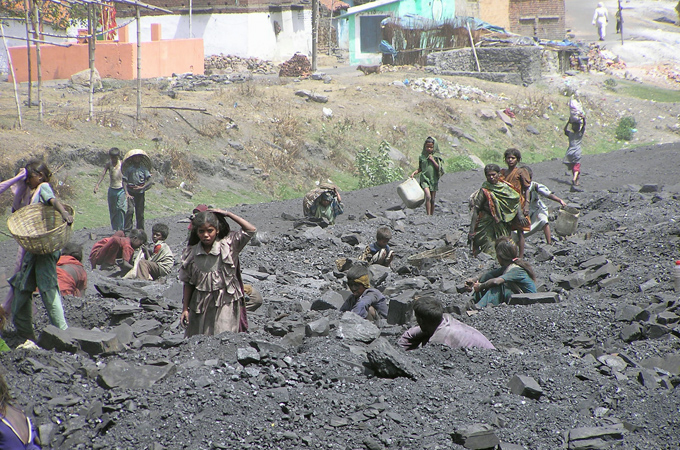Child miners: India's crying shame

Every morning at the crack of dawn, 13-year-old Sagar Kujur joins many others of his age and even younger to trudge towards the coal pits of Ramgarh in Jharkhand, a state in eastern India.
Armed with shovels and cane baskets, they tip-toe over the jagged surface, settle down in a corner and start digging a hole through rocks of solid coal. A few back-breaking hours later, their baskets fill up with pieces of coal that had been chipped away, and they hurry to the nearest market to sell their day’s treasure.
Children like Kujur, blackened with coal dust, serve as daily reminders to the dark secrets of the 15,000-odd coal mines in the state.
Jharkhand is mineral-rich, but a majority of its people is dirt poor. As in the rest of India where, according to UNICEF, some 28 million children work to supplement their families’ meagre income, 400,000 children aged between five and 14 work in Jharkhand. Given the proximity to mines, many children work in them.
It is dangerous to work in the mines, particularly those that are underground where fatal cave-ins are frequently reported. But their penury leaves the children with few choices. “I know there is danger in this work, but at the end of the day, it is the money that matters,” Kujur said.
Officially, the mines are leased to state-owned companies such as the Central Coalfield Limited (CCL), Bharat Cooking Coal Limited (BCCL) and Eastern Coalfield Limited (ECL).
Illegal mining
However, people venture into these mines to extract coal illegally. At times, they burrow into mines that have been abandoned, or poach into mines that are operational but not properly policed.
With thousands of mines and a large area to cover, it is often impossible for the companies to monitor every mine, allowing an illegal mining industry to flourish.
Government figures also point to the deep-rooted scourge of illegal mining. According to the ministry of coal, 583 cases of illegal mining were reported in the state between 2006 and 2010. Strangely, however, not a single person was arrested for the trade. In the four years up to September 2009, 21,702 tonnes of illegally mined coal were seized by officials.
According to a report published by the Jamshedpur-based Xavier Labour Relation Institute in 2008, there are some 195 illegal mining sites under CCL’s purview, 49 under BCCL and 203 under ECL.
State-owned coal companies blamed the government for failing to curb illegal mining. “Inadequate infrastructure of law enforcement agencies offers scope for illegal extraction of coal from the area. We are working according to the Mines and Minerals Act, but it is not possible on our part to curb illegal mining from the area,” said R R Prasad, the public relations officer of BCCL.
Similarly, R B Sharma, the general manager of CCL in Ramgarh, said that although he is well-aware of the situation, “it’s a vast area and fencing the entire area is not possible. The state government never enforced sufficient force to monitor the area”.
ECL officials could not be reached for comment.
‘There is no other option’
Despite the 1952 Indian Mines Act that stipulates that no one under the age of 18 can be employed in the mines, many children do so anyway.
Rules mean little to the children who claw coal from the guts of the earth for a living. “I used to study, but then who will earn for my family? There is no other option. All my family members have to work together all day so that we don’t starve from hunger,” says Rakesh Kumar, 12, another child miner. “On a normal day, we earn 200 rupees ($3.60) by going into these mines.”
Their future looks as bleak as the dark mines they are forced to work in. Schools are scarce in the region, and education is often seen to be a luxury.
“We know that we are gambling with our lives, and our children’s lives, every day - but with no poverty alleviation projects or alternate forms of employment reaching this part of the state, we are forced to mine coal for our livelihood,” said Shanti Tete, a woman working in the mines.
Death plays “hide and seek” with the miners each day, says 34-year-old Komal Devi. Each year, the mines in this area kill around 20 workers including six or seven children, pointed out Sanjit Kumar of the non-governmental organisation SRIJAN.
Illegal mining also bleeds the government of revenue. “Because of unauthorised mining, coal companies bear a loss of $20m per year, and [the] state government suffers a loss of $6.2m every year,” says Radhe Ramen, the deputy director of the mining department.
Social activists also talk of the high toll the illegal trade exacts on children, ranging from alcoholism to rising juvenile crime.
The government, however, has failed to curb the illegal trade and all its attendant evils. “We tried to enroll people in the Mahatma Gandhi National Rural Employment Guarantee Act work, but people do not want to get involved as they do not see enough money,” explains Santhosh Satpathy of Jharkhand’s rural development department.
As many as “10,000 families might be earning their livelihood by ‘rat-hole’ mining in the area”, he said. “As the area has a history of mining - both legal and illicit - one solution may be to legalise the unlawful mining, and provide workers with sufficient safety training.”
For children like Kujur, though, the debate is of little consequence. What matters is going out every day to chip the coal and cart them to the market for some money. It’s no child’s play, but many of Jharkhand’s children are left without any choice.
You can return to the main Market News page, or press the Back button on your browser.

